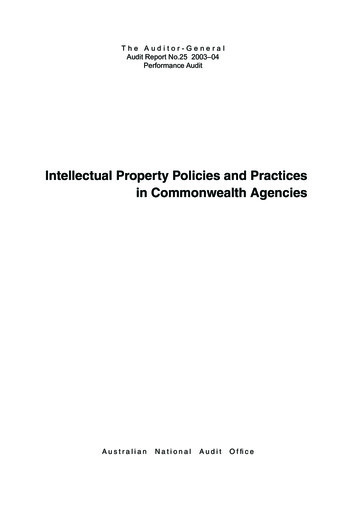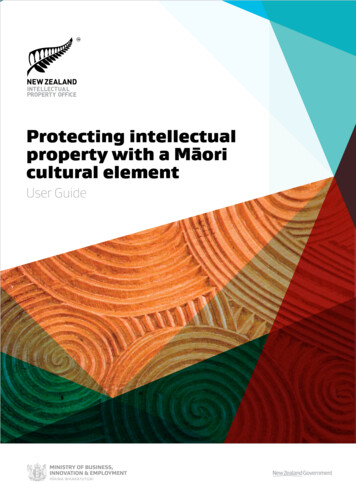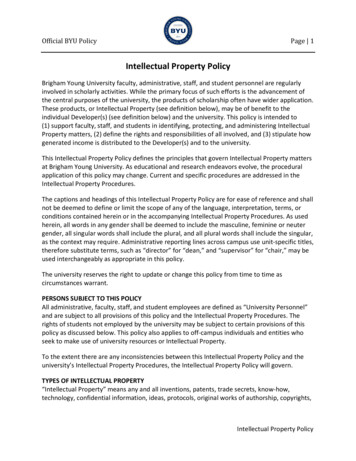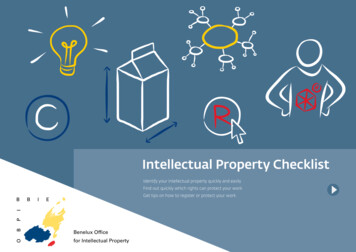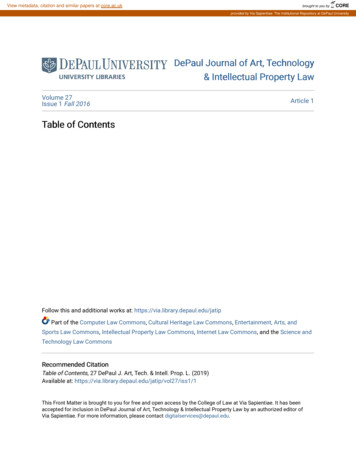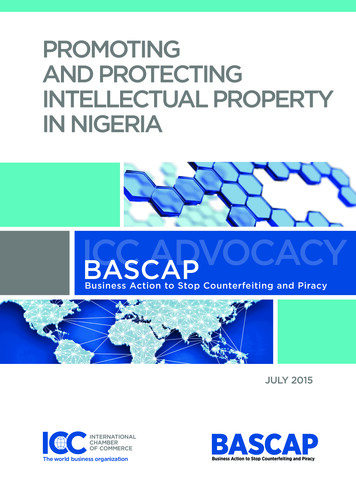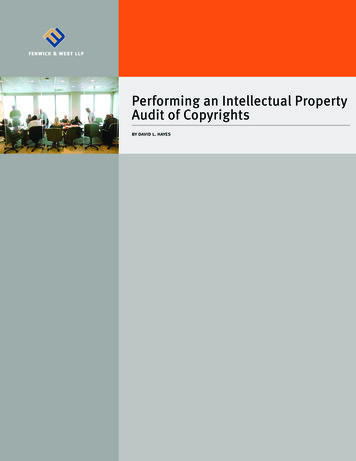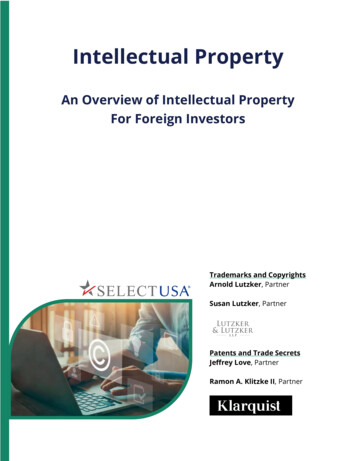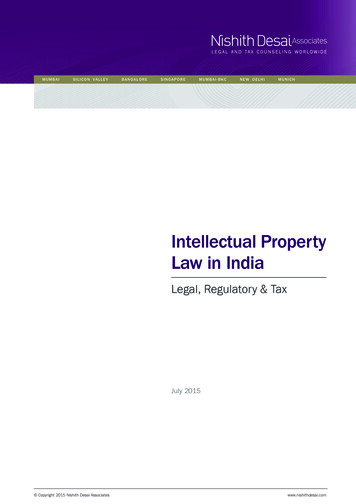
Transcription
M UM B A IS I L I C O N VA L L E YBANGALORES I NG A P OREM UM BA I -BK CNEW DELH IM UNI CHIntellectual PropertyLaw in IndiaLegal, Regulatory & TaxJuly 2015 Copyright 2015 Nishith Desai Associateswww.nishithdesai.com
Intellectual Property Law in IndiaLegal, Regulatory & TaxAbout NDANishith Desai Associates (NDA) is a research based international law firm with offices in Mumbai, Bangalore,Silicon Valley, Singapore, New Delhi, Munich. We specialize in strategic legal, regulatory and tax advice coupledwith industry expertise in an integrated manner. We focus on niche areas in which we provide significant valueand are invariably involved in select highly complex, innovative transactions. Our key clients include marqueerepeat Fortune 500 clientele.Core practice areas include International Tax, International Tax Litigation, Litigation & Dispute Resolution,Fund Formation, Fund Investments, Capital Markets, Employment and HR, Intellectual Property, Corporate& Securities Law, Competition Law, Mergers & Acquisitions, JVs & Restructuring, General Commercial Lawand Succession and Estate Planning. Our specialized industry niches include financial services, IT and telecom,pharma and life sciences, education, media and entertainment, real estate and infrastructure.Nishith Desai Associates has been ranked as the Most Innovative Indian Law Firm (2014) and the Second MostInnovative Asia - Pacific Law Firm (2014) at the Innovative Lawyers Asia-Pacific Awards by the Financial Times- RSG Consulting. IFLR1000 has ranked Nishith Desai Associates in Tier 1 for Private Equity (2014). Chambersand Partners has ranked us as # 1 for Tax and Technology-Media-Telecom (2014). Legal 500 has ranked us in tier1 for Investment Funds, Tax and Technology-Media-Telecom (TMT) practices (2011/2012/2013/2014). IBLJ (IndiaBusiness Law Journal) has awarded Nishith Desai Associates for Private equity & venture capital, Structuredfinance & securitization, TMT and Taxation in 2014. IDEX Legal has recognized Nishith Desai as the ManagingPartner of the Year (2014). Legal Era, a prestigious Legal Media Group has recognized Nishith Desai Associatesas the Best Tax Law Firm of the Year (2013). Chambers & Partners has ranked us as # 1 for Tax, TMT and PrivateEquity (2013). For the third consecutive year, International Financial Law Review (a Euromoney publication) hasrecognized us as the Indian “Firm of the Year” (2012) for our Technology - Media - Telecom (TMT) practice. Wehave been named an ASIAN-MENA COUNSEL ‘IN-HOUSE COMMUNITY FIRM OF THE YEAR’ in India for LifeSciences practice (2012) and also for International Arbitration (2011). We have received honorable mentions inAsian MENA Counsel Magazine for Alternative Investment Funds, Antitrust/Competition, Corporate and M&A,TMT and being Most Responsive Domestic Firm (2012). We have been ranked as the best performing Indianlaw firm of the year by the RSG India Consulting in its client satisfaction report (2011). Chambers & Partners hasranked us # 1 for Tax, TMT and Real Estate – FDI (2011). We’ve received honorable mentions in Asian MENACounsel Magazine for Alternative Investment Funds, International Arbitration, Real Estate and Taxation for theyear 2010. We have been adjudged the winner of the Indian Law Firm of the Year 2010 for TMT by IFLR. We havewon the prestigious “Asian-Counsel’s Socially Responsible Deals of the Year 2009” by Pacific Business Press, inaddition to being Asian-Counsel Firm of the Year 2009 for the practice areas of Private Equity and Taxation inIndia. Indian Business Law Journal listed our Tax, PE & VC and Technology-Media-Telecom (TMT) practices inthe India Law Firm Awards 2009. Legal 500 (Asia-Pacific) has also ranked us #1 in these practices for 2009-2010.We have been ranked the highest for ‘Quality’ in the Financial Times – RSG Consulting ranking of Indian lawfirms in 2009. The Tax Directors Handbook, 2009 lauded us for our constant and innovative out-of-the-box ideas.Other past recognitions include being named the Indian Law Firm of the Year 2000 and Asian Law Firm of theYear (Pro Bono) 2001 by the International Financial Law Review, a Euromoney publication. In an Asia surveyby International Tax Review (September 2003), we were voted as a top-ranking law firm and recognized for ourcross-border structuring work.Our research oriented approach has also led to the team members being recognized and felicitated for thoughtleadership. Consecutively for the fifth year in 2010, NDAites have won the global competition for dissertationsat the International Bar Association. Nishith Desai, Founder of Nishith Desai Associates, has been voted ‘ExternalCounsel of the Year 2009’ by Asian Counsel and Pacific Business Press and the ‘Most in Demand Practitioners’ byChambers Asia 2009. He has also been ranked No. 28 in a global Top 50 “Gold List” by Tax Business, a UK-basedjournal for the international tax community. He is listed in the Lex Witness ‘Hall of fame: Top 50’ individualswho have helped shape the legal landscape of modern India. He is also the recipient of Prof. Yunus ‘SocialBusiness Pioneer of India’ – 2010 award.We believe strongly in constant knowledge expansion and have developed dynamic Knowledge Management(‘KM’) and Continuing Education (‘CE’) programs, conducted both in-house and for select invitees. KM andCE programs cover key events, global and national trends as they unfold and examine case studies, debate and Nishith Desai Associates 2015
Provided upon request onlyanalyze emerging legal, regulatory and tax issues, serving as an effective forum for cross pollination of ideas.Our trust-based, non-hierarchical, democratically managed organization that leverages research and knowledgeto deliver premium services, high value, and a unique employer proposition has now been developed intoa global case study and published by John Wiley & Sons, USA in a feature titled ‘Management by Trust in aDemocratic Enterprise: A Law Firm Shapes Organizational Behavior to Create Competitive Advantage’ in theSeptember 2009 issue of Global Business and Organizational Excellence (GBOE).DisclaimerThis paper is a copyright of Nishith Desai Associates. No reader should act on the basis of any statementcontained herein without seeking professional advice. The authors and the firm expressly disclaim all and anyliability to any person who has read this paper, or otherwise, in respect of anything, and of consequences ofanything done, or omitted to be done by any such person in reliance upon the contents of this paper.ContactFor any help or assistance please email us on ndaconnect@nishithdesai.com orvisit us at www.nishithdesai.comPlease see the last page of this paper for the most recent research papers by our experts. Nishith Desai Associates 2015
Intellectual Property Law in IndiaLegal, Regulatory & TaxContent1. INTRODUCTION 012. LEGISLATION 023. TRADEMARKS 034. DOMAIN NAMES 105. COPYRIGHTS 116. PATENTS 177. DESIGNS 308. GEOGRAPHICAL INDICATIONS OF GOODS (REGISTRATION AND PROTECTION) ACT, 1999329. SEMICONDUCTOR INTEGRATED CIRCUITS LAYOUT DESIGN ACT, 20003410.THE PROTECTION OF PLANT AND VARIETIES AND FARMERS RIGHTS ACT, 20013611.THE BIOLOGICAL DIVERSITY ACT, 20023812.CONFIDENTIAL INFORMATION & TRADE SECRETS3913.INTERNATIONAL CONVENTIONS 4114.SPECIAL TRIBUNALS 4215.TAX REGIME IN INDIA 4316.ENFORCEMENT 4617.MEASURES TO CHECK IMPORT OF INFRINGING GOODS48CONCLUSION 50 Nishith Desai Associates 2015
Intellectual Property Law in IndiaLegal, Regulatory & Tax1. IntroductionWith the advent of the knowledge and informationtechnology era, intellectual capital has gainedsubstantial importance. Consequently, IntellectualProperty (“IP”) and rights attached thereto havebecome precious commodities and are being fiercelyprotected. In recent years, especially during thelast decade, the world has witnessed an increasingnumber of cross-border transactions. Companies arecarrying on business in several countries and sellingtheir goods and services to entities in multiplelocations across the world. Since intellectualproperty rights (“IPRs”) are country-specific, it isimperative, in a global economy, to ascertain andanalyze the nature of protection afforded to IPRsin each jurisdiction. This paper analyzes and dealswith the IP law regime in India and the protectionsprovided thereunder.There are well-established statutory, administrative,and judicial frameworks for safeguarding IPRs in Nishith Desai Associates 2015India. It becomes pertinent to mention here thatIndia has complied with its obligations under theAgreement on Trade Related Intellectual PropertyRights (“TRIPS”) by enacting the necessary statutesand amending the existing statues. Well-knowninternational trademarks have been affordedprotection in India in the past by the Indian courtsdespite the fact that these trade marks were notregistered in India. Computer databases and softwareprograms have been protected under the copyrightlaws in India and pursuant to this; softwarecompanies have successfully curtailed piracythrough judicial intervention. Although trade secretsand know-how are not protected by any specificstatutory law in India, they are protected underthe common law. The courts, under the doctrine ofbreach of confidentiality, have granted protection totrade secrets.1
Provided upon request only2. LegislationThe Trade and Merchandise Marks Act, 1958(“TM Act, 1958”) has been replaced by the TradeMarks Act, 1999, The Copyright Act, 1957 has beenamended to protect computer programs as “literarywork”; The Patent Act, 1970 has been amended bythe Amendment Acts of 1999 and 2002 and 2005. TheDesigns Act of 1911 has been completely replaced bythe Designs Act of 2000. The Geographical Indications of Goods(Registration and protection) Act, 1999; The Semiconductor Integrated Circuits LayoutDesign Act, 2000; The Protection of Plants & Varieties and FarmersRights Act, 2001; and The Biological Diversity Act, 2002The following laws have been enacted to protectnewly recognized species of intellectual property inIndia:These acts, and particularly the impact of recentamendments to the acts, are discussed in greaterdetail in the ensuing sections.2 Nishith Desai Associates 2015
Intellectual Property Law in IndiaLegal, Regulatory & Tax3. TrademarksIn India, trademarks are protected both understatutory law and common law. The Trade andMerchandise Marks Act, 1940 (“TM Act, 1940”)was the first law in this regard in India, which wasreplaced later by the TM Act, 1958. The Trade MarksAct, 1999 (“TM Act”) - which has replaced the TMAct, 1958 - came into effect on September 15, 2003and is in compliance with the TRIPS obligations.The TM Act allows for the registration of servicemarks and three-dimensional marks as well. Indiafollows the NICE Classification of goods and services,which is incorporated in the Schedule to the Rules1under the TM Act. A Trade Marks Registry had beenestablished for the purposes of the TM Act, 1940,which has continued to function under the TM Act,1958 and TM Act. The Trade Marks Registry is underthe charge of the Registrar of Trademarks. The headoffice of the Trade Marks Registry is in Bombay(Mumbai) and its branches are at Calcutta (Kolkata),Delhi, Madras (Chennai), and Ahmedabad. Theterritorial jurisdiction of each office has also beenallocated.In addition to trademarks, the following categories ofmarks can also be registered under the TM Act: Certification marks are given for compliancewith defined standards, but are not confinedto any membership. Such marks are grantedto anyone who can certify that the productsinvolved meet certain established standards.The internationally accepted “ISO 9000” qualitystandard is an example of a widely recognizedcertification mark.Collective marks can be owned by anyassociation. The members of such associationswill be allowed to use the collective mark toidentify themselves with a level of quality andother requirements and standards set by theassociation. Examples of such associations wouldbe those representing accountants, engineers orarchitects.I. Unconventional MarksIndia’s Trade Mark Registry has begun to recognize“unconventional trademarks” and has extendedtrademark protection to a sound mark. On August18, 2008, India’s first “sound mark” was granted toSunnyvale, California-based Internet firm YahooInc.’s three-note Yahoo yodel by the Delhi branch ofthe Trademark Registry. It was registered in classes35, 38 and 42 for a series of goods including email,advertising and business services and managingwebsites.Under the TM Act, the term ‘mark’ is defined toinclude ‘a device, brand, heading, label, ticket,name, signature, word, letter, numeral, shape ofgoods, packaging or, combination of colors, or anycombination thereof.’ Thus, the list of instances ofmarks is inclusive and not exhaustive. Any markcapable of being ‘graphically represented’ andindicative of a trade connection with the proprietoris entitled to get registered as a trademark underthe TM Act. This interpretation opens the scope oftrademark protection to unconventional trademarkslike sound marks provided they satisfy the ‘graphicalrepresentation’ test and are not prohibited underSection 9 and 11 of the Act. The only way the markmay be described in the application for trademarkis by way of “graphical representation”. However,the TM Act or the rules framed thereunder do notcontemplate the form of submission of records of theunconventional trademarks.II. Scope of ‘GraphicalRepresentation’Trademark Rules define “graphical representation”as representation of a trademark for goods or2services in paper form. Therefore, sound markscan be represented on paper either in descriptiveform e.g. kukelekuuuuu (registered as Dutch soundmark - onomatopoeia which sounds like the call ofa cock) or as traditional musical notations e.g. D#,E etc. Other alternative methods for their visualrepresentation have also emerged like depictions byoscillogram; spectrum, spectrogram and sonogramare now being accepted in other jurisdictions.However, such representations must be handledcarefully in order to meet the requirements oftrademark offices in India. In the case of Yahoo’sYodel mark, they represented the mark usingmusical notations.1.Classes of Goods and Services: Classes 1 to 34 covers goods while classes 35 to 45 cover services.2.See Rule 2 (k), The Trademark Rules, 2002. Nishith Desai Associates 20153
TrademarksProvided upon request onlyIII. Syncing the Indian Law toTide over the Hurdles ofRegistrationboundaries of protection of unconventional marks.Reducing a sensory mark to a written descriptionon paper may not be always possible. A “graphicaldescription” of a sound mark should clearly identifythe exact sound, else the enforcement of the same,would lead to practical issues. E.g. the search resultof the trademark at Trade Mark Registry wouldnot be accurate if the mark is not appropriatelydescribed. Merely musical notes without a listing ofthe note pattern would not provide enough sensoryinformation to contemplate the scope of protectionon the mark. Musical notations alone are neither aclear nor precise description of the sound mark andgives no information about the pitch and durationof the sounds forming the melody. The graphicalrepresentations should be clear, precise, selfcontained, easily accessible, intelligible, durable andobjective. A stave divided into bars and showing, inparticular, a clef, musical notes and rests whose formindicates the relative value and, where appropriate,accidentals (sharp, flat, natural) - all of thesedetermine the pitch and duration of the sounds.This may constitute a faithful representation of thesequence of sounds forming the melody in respect of3which registration is sought.Any person claiming to be the proprietor of atrademark used or proposed to be used by thatperson can file an application for registration.The application may be made in the name ofthe individual, partner of a firm, a company, anygovernment department, a trust, or even in nameof joint applicants. Domestic and internationalapplicants are treated at par. An application can alsobe filed on behalf of a company that is about to beincorporated or registered under the Companies Act,41956.With regard to onomatopoeias, there is lack ofconsistency between the onomatopoeia itself, aspronounced, and the actual sound or noise which itpurports to imitate phonetically. Practical difficultiesare bound to arise when trademark searches will berequired. For e.g. if the sound mark is a crow’s calland is described as kukelekuuuuu, the same maybe spelt differently or represented with musicalnotations. The procedure may be highly complicatedas musical notations need to be matched againstalphabets. To simplify matters, a sample of the soundmay be submitted with the application. A separatedatabase of these sound marks can be created andrules for determination of deceptive similaritybetween sound marks should be developed.Indian Trade Mark Registry may have enhanced thescope of protection under the trademark umbrella,but there need to be clear guidelines for description,recording and protection that will help define the3.Shield Mark BV v. Joost Kist h.o.d.n. Memex, (1999) RPC 392.4.Section 46 of the TM Act.4IV. Who can Apply?V. Is Prior use Required?Prior use of the trademark is not a prerequisitefor filing application or its registration and anapplication may be made for registration even ifthe intention of the applicants is bona fide use ofthe trademark in the future. In such a case, theapplication can be filed on a “proposed to be usedbasis”. However, in the case of descriptive marks,the Trade Marks Registry usually insists upon proofof use of the mark and the distinctiveness acquiredthrough such use before granting a registration.VI. Is a Prior Search Necessary?Though a prior search for a conflicting trademarkis not a prerequisite for filing an application, it isadvisable to carry out a search and maintain thesearch results. In opposition proceedings or ininfringement / passing off actions, such searchreports act as proof of honesty and good faith in theadoption of the marks.In a move to curb the spread and sale of counterfeitdrugs, the Drugs Control Department of the NationalTerritory of Delhi has made search reports fromthe Registrar of Trade Marks mandatory beforeapproving any drug-manufacturing license under aparticular brand name. Nishith Desai Associates 2015
Intellectual Property Law in IndiaLegal, Regulatory & TaxThis initiative by the Delhi Drugs Authority isin pursuance of the Indian Supreme Court’s (SC)observations in the case of Cadila Health Care Ltd.v. Cadila Pharmaceuticals Ltd. (decided on March526, 2001). If adopted in the other states in India, thisprovision will eliminate the chances of approvalof a deceptively similar and look-alike brand of theexisting products.VII. What is the Process ofRegistration?The application for trademark registration mustcontain a clear reproduction of the sign, includingany colors, forms, or three-dimensional features.These forms need to be filed with the appropriateoffice of the Trade Marks Registry. The sign mustfulfill certain conditions in order to be protectedas a trademark – or as another type of mark – andmust indicate the class of goods / services to which6it would apply. The TM Act has laid down absolute7and relative grounds of refusal of trademarkregistration. These grounds are akin to the provisionsof the UK Trademark Act of 1994.The process of registration of trademarks under theTM Act can be explained utilizing the diagram onthe following page:SELECTION OF THEMARKMark should be distinctive and should not be in the prohibited category.SEARCH BEFOREAPPLICATIONCarry out a search at the Trade Marks Registry, to find out if same or similar marks areeither registered or pending registration. This is advisable although not compulsory.FILING OF THEAPPLICATIONUnder the Trade Marks Act, a single application with respect to multiple classes can befiled.NUMBERING OF THEAPPLICATIONThe application is dated and numbered, and a copy is returned to the applicant /attorney. Once the mark is registered, this number is deemed to be the RegistrationNumber.The Trade Marks Registry sends the “Official Examination Report” asking forMEETING THE OFFICIALclarificatioans, if any, and also cites identical or deceptively similar marks alreadyOBJECTIONSregistered or pending registration. The applicant has to overcome the objections.ADVERTISING OF THEAPPLICATIONThe application is thereafter published in the “Trade Marks Journal,” which is aGovernment of India publication, published by the Trade Marks Registry.ACCEPTANCE OF THEAPPLICATIONAfter publication, if the application is not opposed within the specified oppositionperiod (four months), then the registration is granted. On the other hand, if it isopposed by a third party, the registration is granted only if the matter is decided infavor of the applicant.5.(2001) SCL 534. In paragraph 41 of the judgment, the Supreme Court observed:“Keeping in view the provisions of Section 17-B of the Drugs and Cosmetics Act, 1940 which, inter alia, indicates an imitation or resemblance ofanother drug in a manner likely to deceive being regarded as a spurious drug it is but proper that before granting permission to manufacture a drugunder a brand name the authority under that Act is satisfied that there will be no confusion or deception in the market. The authorities shouldconsider requiring such an applicant to submit an official search report from the Trade Mark office pertaining to the trade mark in question whichwill enable the drug authority to arrive at a correct conclusion.”6.Section 9 of the TM Act.7.Section 11 of the TM Act. Nishith Desai Associates 20155
TrademarksProvided upon request onlyOPPOSITIONPROCEEDINGSAfter the objections are successfully met and answers are provided to the queries,the Trade Marks Registry issues an official letter intimating their acceptance of theapplication.ISSUE OF CERTIFICATEOF REGISTRATIONRegistration of a trademark normally takes four to five years. However, when theregistration certificate is issued, it is always effective from the date on which theapplication is filed.VIII. Can the Registration Processbe Expedited?XI. Grounds for Cancellation /RevocationAfter receipt of the official number of an application,the applicant may request an expedited examinationof a registration application, together with adeclaration stating the reason for the request anda payment of five times the application fee. If theRegistrar of Trademarks is satisfied with the reason,the examination of the application is expeditedand the examination report is issued within threemonths of the date of such request. If such a request8is rejected after the hearing, the fee paid is refunded.The following are some of the grounds on whichthe registration of a trademark can be removed orcancelled: The trademark was registered without any bonafide intention on the part of the applicant touse the trademark and there has been no bonafide use of the trademark for the time being upto a date three months before the date of the9application for removal; or That up to a date three months before the date ofapplication for removal, a continuous period offive years from the date on which the trademarkis actually entered on the register or longerhas elapsed during which the trademark wasregistered and during which there was no bona10fide use thereof; or The trademark was registered without sufficientcause, or the trademark is wrongly remaining on11the Register.IX. What is the Term ofRegistration?The registration is valid for ten years and isrenewable for a subsequent period of ten years. Nonrenewal leads to a lapse of registration. However,there is a procedure whereby a lapsed registrationcan be restored.X. How can the Registration of aTrademark be Cancelled?An application for cancellation or rectification ofregistration of a trademark can only be filed by theaggrieved person (e.g. prior users of the mark). Suchan application must be filed with the Registrar ofTrade Marks or the Appellate Board.8.Rule 38 of the Trade Marks Rules, 2002.9.Section 47(1) (a) of the TM Act.XII. Assignment of Trademarks12A registered trademark can be assigned ortransmitted with or without the goodwill of thebusiness concerned, and in respect of either or allof the goods or services in respect of which thetrademark is registered. An unregistered trademarkcan be assigned or transmitted with or withoutthe goodwill of the business concerned. However,in respect of assignment of trademarks (registeredor unregistered) without goodwill of the businessconcerned, the prescribed procedure has to be10. Section 47(1) (b) of the TM Act.11. Section 57 of the TM Act.12. Sections 37 to 45 of the TM Act deal with the provisions of the assignment and transmission of the trade mark.6 Nishith Desai Associates 2015
Intellectual Property Law in IndiaLegal, Regulatory & Taxfollowed, which inter alia, includes advertisementof the proposed assignment to be published in thenewspapers. The Registrar of Trade Marks couldimpose certain restrictions and conditions for theassignment or transmission of the trademark. To beeffective, the assignment or transmission must berecorded with the Registrar of Trade Marks.XVI. Infringement of TrademarkRegistration of a trademark is a prerequisite forinitiating an infringement action. The followingessential conditions must exist for initiation of an16infringement action: The allegedly infringing mark must be eitheridentical or deceptively similar to the registeredtrademark; The goods / services in relation to which theallegedly infringing mark is used must bespecifically covered by the registration of theregistered trademark; The use of the allegedly infringing mark must bein the course of trade; and The use must be in such a manner as to renderthe use likely to be taken as being used as atrademark.XIII. License of TrademarksThe TM Act provides for a registration procedureof registered / licensed users of the registeredtrademark. The benefit of use by the registered /license user accrues to the benefit of the mark’s13proprietor. The TM Act recognizes non-registeredlicensed use if only such use is with the consent ofthe proprietor as embodied in a written agreement14and if such user satisfies the prescribed conditions.Owners of Indian registered trademarks, who arelocated abroad, having no presence in India, can usetheir trademarks in India by granting licenses to theIndian parties.XIV. Rights Conferred byRegistration15The registration of a trademark gives the registeredproprietor the exclusive right to use the trademarkin relation to the goods or services for which itis registered and to obtain relief with respect toinfringement of the same. Registration acts as apublic notice to others, informing them that theyshould not use the trademarks which are registeredor pending for registration.XV. Paris ConventionReciprocity for the purpose of claiming priority isallowed from the applications originating from theParis Convention countries if filed within 6 monthsfrom the date of priority.A registered trademark is also infringed by use of amark when because of: Its identity with registered trademark andsimilarity with goods / services covered byregistration; or Its similarity with registered trademark andidentity with goods / services covered byregistration; or Its identity with registered trademark andidentity with goods / services covered byregistrationIs likely to cause confusion on the part of the public(in case 3 above, confusion is presumed), or whichis likely to have an association with the registered17trademark.If an identical or similar mark is used with respect togoods or services which are not similar to those forwhich a registered trademark is registered, such useamounts to infringement if a registered trademarkhas reputation in India and the use of the markwithout due cause takes unfair advantage of or isdetrimental to the distinctive character or repute of18the registered trademark.13. Section 48(2) of the TM Act.14. Section 2(1) (r) read with Section 48(2) of the TM Act.15. Section 28 of the TM Act.16. Section 29(1) of the TM Act.17. Sections 29(2) and (3) of the TM Act.18. Section 29(4) of the TM Act. Nishith Desai Associates 20157
TrademarksProvided upon request onlyUnder the TM Act, the following acts would alsoamount to an infringement of the RTM: Use of the registered trademark as a trade nameor part of the trade name dealing in same goodsor services for which the registered trademark is19registered; orUse of the trademark in advertising if suchadvertising takes unfair advantage of and iscontrary to the honest practice in industrialor commercial matters, or is detrimental to itsdistinctive character; or against the reputation of20the trademark.Under the TM Act, even oral use of the mark can21constitute infringement.XVII.Who can sue forInfringement?The registered proprietor, his heirs and the registereduser(s) can sue for infringement. An assignee of aregistered trademark can also sue for infringement.A passing off suit can be converted into a combinedaction of infringement and passing off, if theregistration of the trademark is obtained before thefinal hearing of the passing off suit.XVIII. Passing OffThe user of an unregistered trademark is barredfrom instituting an infringement action. However,if the mark in question has become well known inIndia, the user of such a trademark is not withoutrecourse and may seek a remedy by means of apassing off action. The purpose of this tort is toprotect commercial goodwill and to ensure thatone’s business reputation is not exploited. Sincebusiness goodwill is an asset and therefore a speciesof property, the law protects it against encroachmentas such. I
Intellectual Property La in India 1 Legal, Regulatory & Tax 1. Introduction With the advent of the knowledge and information technology era, intellectual capital has gained substantial importance. Consequently, Intellectual Property ("IP") and rights attached thereto have become precious commodities and are being fiercely protected.
